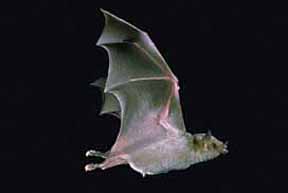Large Mexican flower bat
| Large Mexican flower bat | ||||||||||||
|---|---|---|---|---|---|---|---|---|---|---|---|---|

Large Mexican flower bat ( Leptonycteris nivalis ) |
||||||||||||
| Systematics | ||||||||||||
|
||||||||||||
| Scientific name | ||||||||||||
| Leptonycteris nivalis | ||||||||||||
| ( Saussure , 1860) |
The large Mexican flower bat ( Leptonycteris nivalis ) is a bat from the leaf-nosed family (Phyllostomidae) that is native to Central America.
The generic name Leptonycteris is derived from the Greek "leptos" (= slender, delicate) and "nycteris" (= bat). The species name nivalis is Latin and means something like "snow white" and probably refers to the silver tips of the fur.
description
The large Mexican flower bat is the largest representative of the genus Leptonycteris with a forearm length of 56.5–59.5 mm and a total length of 83 mm on average . The average weight is 24 g. Leptonycteris nivalis has a longer, less reddish-looking coat than Leptonycteris yerbabuenae . The hair is white at the base, dark brown in the middle and has a silver tip. In contrast to L. yerbabuenae, the tail fly skin is also slightly hairy. Like most representatives of the leaf noses , Leptonycteris nivalis also has a clearly visible nasal leaf .
Way of life
Like most bats, the great Mexican flower bat is nocturnal and occurs in arid and semi-arid regions. During the day it hangs in large groups in caves, mines, hollow trees and abandoned buildings. The largest group ever counted consisted of 10,650 animals hanging close together. Leptonycteris nivalis sometimes shares the hanging places with other species such as Plecotus townsendii , Myotis thysandones and Myotis volans . Leptonycteris nivalis is one of the migrating bat species. Long migrations are necessary on the one hand to search for food, on the other hand because the species does not hibernate and therefore moves from colder to warmer areas in autumn. The great Mexican flower bat feeds primarily on pollen , nectar, and fruits from various cacti and agaves . This diet makes them an important seed disperser and pollinator of many night-flowering plants. The tongue is optimally adapted to the diet and can be extended up to the length of the head. It has small, hair-like papillae on the sides of the tip and a groove in the middle. Thanks to its wide wings, Leptonycteris nivalis is also a skilful, agile flyer that can also hover in front of a flower to absorb the nectar.
distribution
The great Mexican flower bat occurs from Texas to Mexico . The IUCN estimates Leptonycteris nivalis as endangered ( Vulnerable ) because the population size has decreased by over 50% in the last 10 years. The reason for this is mainly the destruction of the habitat.
literature
- A. Pfrimmer Hensley, KT Wilkins (2006) Leptonycteris nivalis. In: Mammalian Species . No. 307, pp. 1-4.